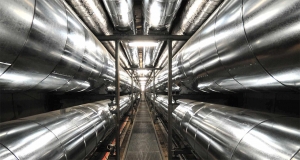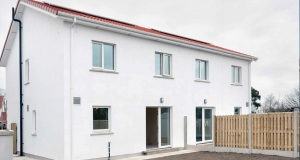- District Heating
- Posted
Group effort

With the age of cheap and abundant fossil fuel energy coming to an end, district heating, where a development is heated from a single, centralised heat source is becoming an increasingly attractive option due to the capital and running cost, efficiency and environmental benefits it can offer. Paraic Davis of Davis Associates mechanical and electrical engineers explains why district heating has become a viable and increasingly popular choice in Ireland.
Over the next few weeks residents will begin moving into a small scheme of houses in Tyrrellspass, Co. Westmeath. The houses are fascinating in their own right; a former orphanage in a crescent of 12 semi-detached houses built by Lord Belvedere in 1842, and now painstakingly restored by Westmeath County Council to their former charming glory. The residents may not be aware of another interesting aspect of the houses; they are heated by a wood pellet-fired district heating system.
District - or group - heating is almost unheard of in Ireland despite being used extensively in other countries. Ballymun was the only example of district heating that Ireland had for many years.
It became widely known in the Eastern Block in the past where, as well as dedicated heating plants, it was employed to use the by-product of electricity generation - namely heat. The ‘waste’ heat would be pumped around offices, residential buildings and factories and, because energy was cheap and the USSR had its own reserves, it wasn’t controlled very efficiently. As in Ballymun, if you were too warm, you opened the windows.
In fact, like so many other plumbing systems, group heating has been around since the Romans. One district heating system in France has been in continuous operation since the 14th century, and many systems have been in operation on college campuses in Europe and North America since the 1850s.
It was the northern Europeans, who didn’t have their own oil fields, who developed the more sophisticated, energy-efficient systems. The heat from their group heating systems could be used in a more controlled way, running the type of heating we’re more familiar with today; residents could adjust thermostats and time clocks to provide heat exactly when and where they needed it.

A 4,900m2 Solar Heating and Biomass plant, Aeroeskobing, Denmark
While other European countries, including the UK, have had group systems for a long time it has been rare in Ireland partly because the ESB has traditionally put its electricity generation stations away from cities, meaning that heat ‘waste’ (60% of the energy) from them was dumped into the sky via cooling towers rather than being pumped into people’s homes. In fact, two of the new generators that have recently been given the go-ahead are also positioned outside cities. That means that they will run at a much lower efficiency than they could if they were in populated areas selling their heat to houses and factories. In Scandinavia group systems have also come from municipal incinerators. It made sense because having an incinerator in everybody’s hot press wouldn’t be practical!
Why district heating?
Group heating makes sense for many reasons and, after a fall in use as natural gas gave rise to small efficient boilers in each apartment, it is undergoing a huge resurgence across the world with old systems being refurbished and thousands of new schemes being built. Its use is also set to rise in Ireland, and we are working on a number of projects that use such schemes.
Efficiency is a major reason for its popularity. Plant is used very efficiently, as well as energy. The average boiler, which is 80-85 per cent efficient, wastes energy by having to constantly start up and shut down to supply heat when it’s required. For a shower your boiler will heat itself, then the water for 20 minutes or so, and then shut down, and cool down. In a group heating system the boilers run continuously, supplying the heat and hot water that’s needed in each home, or apartment.
In an apartment scheme group heating also saves on space and volume. A 15 kilowatt boiler is needed to serve one home; 100 apartments will be served by a boiler much smaller than 100 x 15 kilowatt. District heating can offer reduced plant pace, reduced capital cost, and increased energy efficiency. Instead of having lots of little plant spaces for all of the different buildings or apartments, you just have just one plant space in a central location.
This also gives more flexibility as to what sort of heating or fuel source you use, because you can use fuels that take up more space. One such fuel is wood pellets and chips which are renewable, grown in Ireland, energy efficient and cheaper than fossil fuels. As the energy crisis begins to bite we can see one of the greatest advantages of district heating systems; fuel flexibility. Wood pellets, the fuel used in Tyrrellspass, cost around half the amount that fossil fuels cost; wood chips are even cheaper.
Explained in simple terms; these systems comprise a boiler on one side of a wall and a pellet store on the other. The pellets feed into the boiler as required and the pellet store is topped up periodically.

The pipe end with white collare sleeve of a pre insulated pipe used for District Heating, designed to distribute hot water at 75-80 degrees
We first considered district heating for Emerald Housing, a scheme we are doing with Solearth Architects in Ballymun. This 37-apartment scheme, sponsored by Dublin City Council, is designed to set new benchmarks in energy and water consumption, occupant health, integration with transport, and recycling.
Ironically, we are currently managing the decommissioning of the old Ballymun 30 Megawatt district heating system and dividing the area into five separate sectors, each with a satellite boiler house, prior to the demolition of the last of the ‘old’ Ballymun. One external thermostat on the roof of each building and two within each apartment building controlled the temperature within an entire tower of 90 apartments.
We had originally considered supplying heat to Emerald via pumps and applied to SEI (Sustainable Energy Ireland) for a grant. They suggested wood pellets because heat pumps are powered by electricity, and most of Ireland’s electricity comes from fossil fuel. Construction will start in September.

Davis Associates provided a district heating system at the Belvedere housing scheme, powered by a wood pellet boiler to provide heat and hot water for the 10 homes
The Belvedere housing scheme in Tyrellspass, with de Blacam and Meagher architects in which we’ve installed wood pellet district heating, was commissioned in May and is now up and running. Westmeath Council wanted a heating system that was simple and straightforward to use so rather than putting heating appliances in each unit we decided to centralise it. The boiler and pellet store are housed in an existing (but not listed) shed that was already on the site. The pipes were laid along with other services, as the earth was excavated. The 80 degree water from the district heating system runs through insulated plastic pipes, which are very robust. The wood pellet supplier, Balcas of Enniskillen, delivers a truck load of wood pellets every two or three months to replenish the supply.
At entry point to each house there is a meter to allow the local authority to bill for exact energy use. In some cases these systems can be used with a pre-paid top-up card in which residents pay for their fuel in advance. These systems also allow for meters to be remotely read from outside the home.
While we are interested in wood pellets from a sustainability point of view (thousands of tonnes of waste wood are being land-filled every year) we have found that some of our commercial clients have opted for wood-pellet group heating systems solely because of the economics involved. In two mixed-use developments (one at planning stage, the other at appeal), the landlords are interested in having wood-chip group heating systems so that they can charge tenants 20 per cent less than the current market cost for fuel and yet still make an 60 per cent profit on it, because fuel and running costs are 50% that of conventional individual boilers.
Where a district scheme involves cooling also (in retail, for example), landlords can supply cheap heating and cooling and yet make a killing. In one huge scheme we are working on, the sum that the developer can make from this each year runs into the millions!

Emerald Housing, a 37 apartment scheme in Ballymun will employ a wood pellet fired district heating system for space and water heating
Davis Associates
Davis Associates mechanical and electrical engineers offer innovative and carefully designed engineering solutions. The practice works with the country’s leading architects to seamlessly integrate services with a variety of designs.
The practice has a track record in, and has won awards for, its sustainable solutions and has introduced environmental designs never before seen in Ireland. Among our engineering services are daylight studies, energy studies and feasibility studies, as well as full Building Services design.
Projects have included crèches and medical facilities, through to offices, hotels, housing and private homes.
- paraic davis
- district heating
- integrated renewables
- fossil
- wood pellets
- tyrrellspass
- group
- centralised
Related items
-
 District heating and passive house - are they compatible?
District heating and passive house - are they compatible? -
 Affordable passive scheme that beggars belief
Affordable passive scheme that beggars belief -
Imperative Energy to finance expansion with equity funding
-
180 green jobs at new Mayo bio-processing facility
-
For peat's sake
-
Moate point
-
Central line
-
Renewed efforts
-
Thinking Caps
-
Conscientious objection
-
Green Rooms
-
Economy of scale

